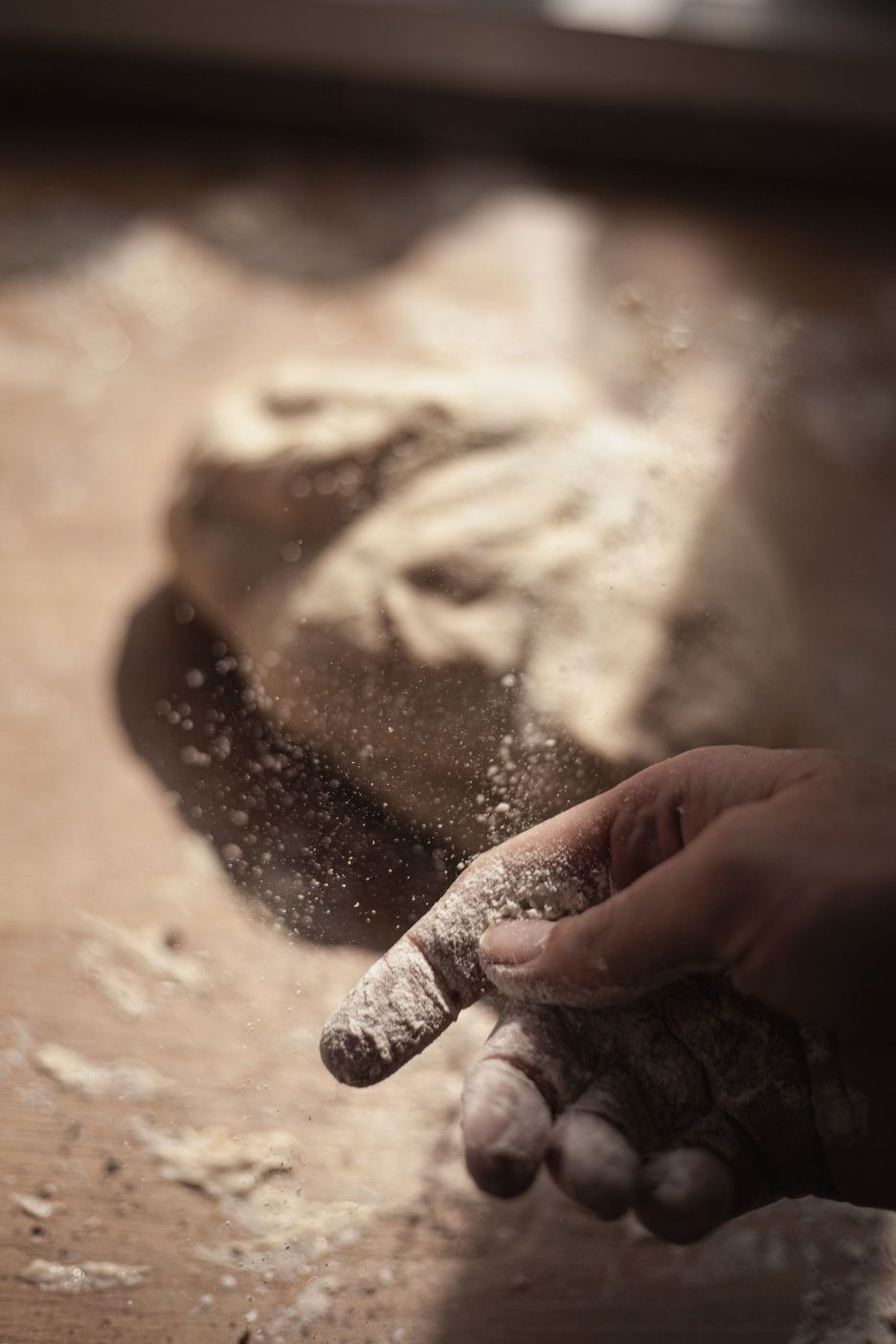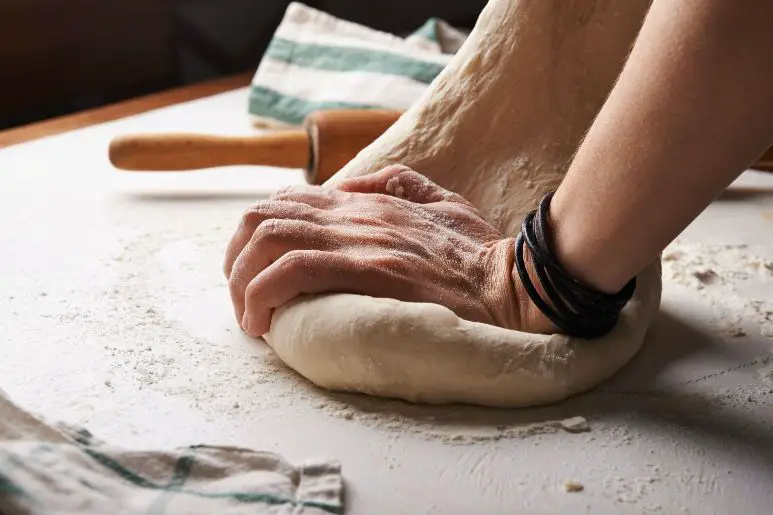Baking bread is an art that combines science, creativity, and a pinch of patience.
While the aroma of freshly baked bread can be utterly satisfying, dealing with dry bread dough can be a frustrating experience for any baker. But fear not!
In this article, I’ll reveal the causes behind dry dough and provide you with helpful tips on how to fix bread dough that is too dry. Let’s dive in.
What Causes Bread Dough to Become Too Dry? Top 7 Reasons
Bread dough can become too dry due to a few potential factors during the mixing and kneading process.
Here are some common reasons:
1. Lack of Proper Hydration
Insufficient hydration stands as a primary culprit behind dry bread dough.
Water serves a critical role in the formation of gluten, a protein network that grants dough its elasticity and softness.
When there isn’t enough water present, the gluten structure struggles to develop fully, resulting in a dough that is tough and lacks moisture.
This, in turn, makes it quite challenging to attain the desired consistency and texture in the final product.
2. Overworking the Dough
While kneading is essential for gluten development, excessive kneading or mixing of the dough can paradoxically lead to dryness.
The process of kneading involves aligning the gluten proteins to create a cohesive network.
However, over-kneading can weaken and break down this network, causing the dough to become dry and crumbly rather than supple and elastic.
3. Incorrect Flour-To-Water Ratio
Achieving the right balance between flour and water is a fundamental aspect of dough hydration.
Deviating from the proper ratio, whether by using too much flour or too little water, can significantly disrupt the dough’s moisture content.
If too much flour is added or too little water is used, the resulting dough may lack the necessary hydration, leading to a dry and stiff consistency.
To ensure optimal hydration, it’s crucial to follow a precise recipe and make adjustments as necessary based on the dough’s feel and appearance.
4. Low-Quality Flour
The choice of flour greatly impacts the texture of the dough. Lower-quality flours tend to have lower protein content, which is vital for gluten formation and moisture retention.

When the gluten network is weakened due to inadequate protein, the dough may struggle to hold onto water, ultimately leading to dryness.
Opting for high-quality flour with sufficient protein content can contribute to a more hydrated and supple dough.
5. Environmental Factors
The surrounding environment, particularly humidity levels, and temperature, can exert a notable influence on dough consistency.
In dry environments, such as those with low humidity, the dough is more prone to losing moisture rapidly.
This can result in dryness, affecting both the texture and overall quality of the bread.
To counteract the impact of environmental conditions, you should consider adjusting the recipe and techniques accordingly.
6. Yeast and Fermentation Issues
Yeast, a microorganism responsible for fermentation, plays a pivotal role in dough development.
Inadequate yeast or improper fermentation can hinder gluten formation and, consequently, lead to dry dough.
Proper yeast activation is essential to kick-start fermentation, which in turn enhances gluten development and ensures a moist, well-structured dough.
Careful attention to yeast quantity, activation, and fermentation duration is necessary to prevent dryness.
7. Salt Imbalance
Salt serves multiple purposes in dough preparation. Beyond enhancing flavor, salt also regulates yeast activity and strengthens gluten.
However, too much salt in bread dough or uneven distribution can disrupt these crucial functions.

Excessive salt can impede yeast activity, slowing down fermentation and affecting gluten formation.
This can result in poor dough development and contribute to dryness. Striking the right balance of salt is vital for both flavor and dough texture.
How to Fix Bread Dough That Is Too Dry – Revealed
If you’ve found yourself in the sticky situation of dealing with dry bread dough, Worry not!
Here are 7 tried-and-true methods to rescue your dry dough and get back on the path to baking success:
1. Adjust Hydration Levels
The moisture content in your dough, known as hydration, significantly influences its texture and pliability.
If your dough is dry, it might be due to an inadequate water-to-flour ratio. To address this, take a gradual approach to rehydrate the dough.
Begin by adding small quantities of water while you knead the dough. Kneading helps distribute the water evenly and encourages absorption.

As you work the dough, you’ll notice it is transitioning from a stiff and dry state to a more supple and slightly sticky consistency.
This transformation indicates that the flour particles are properly hydrated, resulting in a smoother and easier-to-handle dough.
Adjust the water addition as needed until you achieve the desired texture, ensuring that the dough is neither too dry nor overly wet.
2. Incorporate Additional Fat
Fat, such as butter or oil, can play a remarkable role in revitalizing dry dough.
The inclusion of fat serves as a natural lubricant, working to coat the flour particles and bind them together.
This process contributes to a smoother, more cohesive dough that is easier to manipulate.
To reintroduce moisture and pliability, add butter to the bread dough. Add a tablespoon at a time and knead thoroughly after each addition.
Kneading allows the fat to disperse evenly throughout the dough, leading to improved elasticity and a softer texture.
Continue this process until you achieve the desired level of suppleness and the dough becomes more malleable and responsive to your touch.
3. Add Eggs
Eggs serve as a dual-purpose ingredient when rescuing dry dough. Not only are they a nutritional powerhouse, rich in proteins and fats, but they also excel at enhancing moisture content.

When you add eggs to bread dough, they introduce both liquid and fats, two crucial components for combating dryness.
As you knead the dough with the incorporated eggs, you’ll notice a notable increase in moisture and a heightened richness.
The proteins in eggs contribute to the dough’s structure, while the fats provide a luxurious tenderness.
Incorporate beaten eggs gradually into the dry dough, ensuring even distribution by thorough kneading.
This method not only rejuvenates the dough’s hydration but also imparts a delightful depth of flavor and a pleasingly moist texture.
4. Add Some Milk
Milk, whether dairy-based or from plant sources, presents a highly effective remedy for alleviating dry dough.
Its natural emulsifying properties, coupled with its moisture content, work synergistically to soften and hydrate the dough.
To add milk to the bread dough, pour a small quantity at a time while you engage in the kneading process.
This gradual approach allows the dough to absorb the milk evenly, resulting in improved pliability and elasticity.
As you continue to knead, you’ll observe the dough transforming from a dry and rigid state to a more supple and responsive one.
The milk’s contribution leads to a softer and more manageable dough that is well-suited for various culinary creations.
5. Harness the Magic of Steam
When your bread dough has been shaped and appears dry, you can use the power of steam while baking to rescue it.
Introducing steam into the baking environment creates a humid atmosphere that benefits your bread.
The steam helps maintain a soft crust, which is crucial for preserving the moisture within the bread’s interior. This results in a more tender and less dry final product.
6. Use a Preferment
A preferment, such as a poolish or a biga, is a mixture of dough that has been allowed to ferment before being incorporated into the main dough.
This technique has two advantages: it infuses your initially dry bread dough with both moisture and flavor.
By including a preferment in your bread-making process, you’re ensuring that the final product retains more moisture, leading to a softer and more enjoyable texture.
Allowing the preferment to rest before kneading allows it to fully hydrate the flour, optimizing the overall hydration of the dough.
7. Employ Autolyse Technique
The autolyse technique involves a crucial resting period for the dough right after initial mixing.
During this time, the flour is allowed to absorb the liquid, ensuring that it’s thoroughly hydrated before further manipulation.
This step contributes to the development of a smoother and more cohesive dough.
The autolyse technique results in improved dough structure, making it easier to work with during subsequent steps and leading to a final product with enhanced hydration.
How to Fix Bread Dough That Is Too Dry – Conclusion
In conclusion, rescuing dry bread dough is a manageable task with a few simple techniques.
Remember that adding moisture gradually and kneading the dough diligently are key steps to achieving the desired consistency.
Whether using water, milk, or other liquids, it is essential to monitor the dough’s texture and adjust as needed.
Patience and careful attention to detail will lead to a successful restoration of your bread dough, resulting in a beautifully textured and delicious final product.
With these tips in mind, you can confidently fix dry bread dough and continue your baking journey with success.

